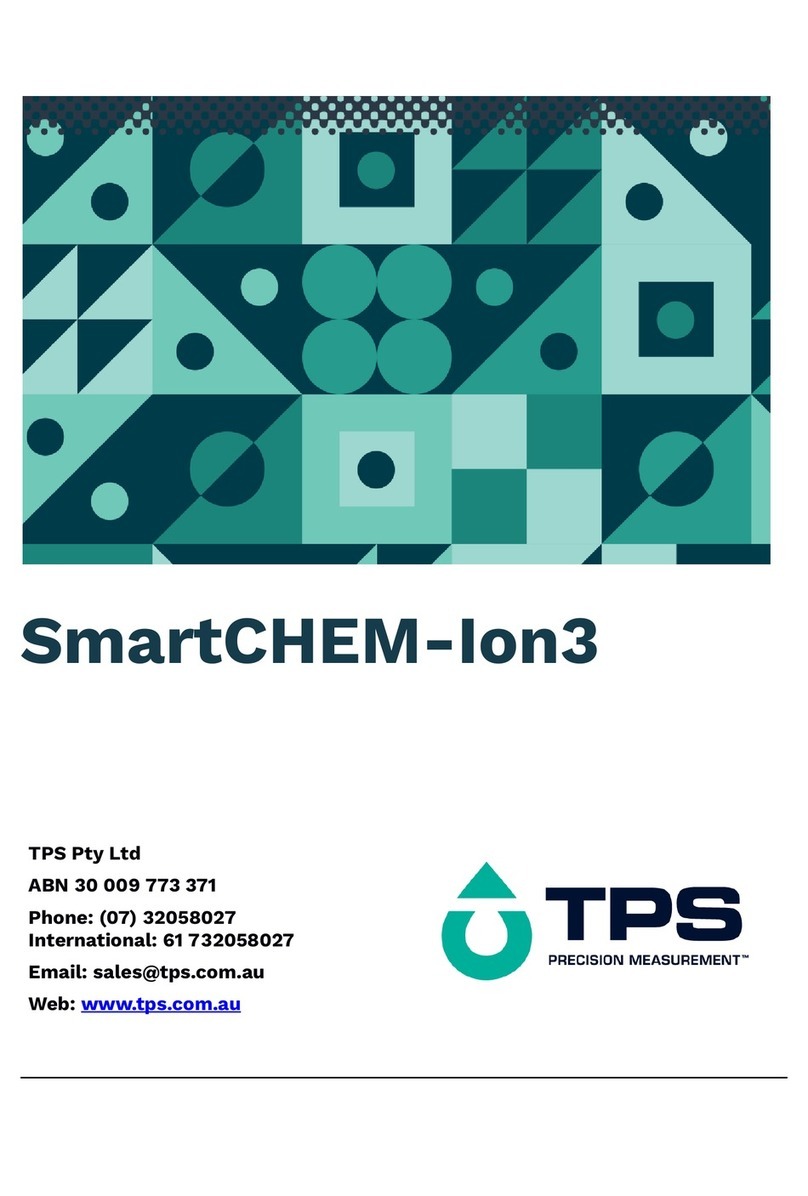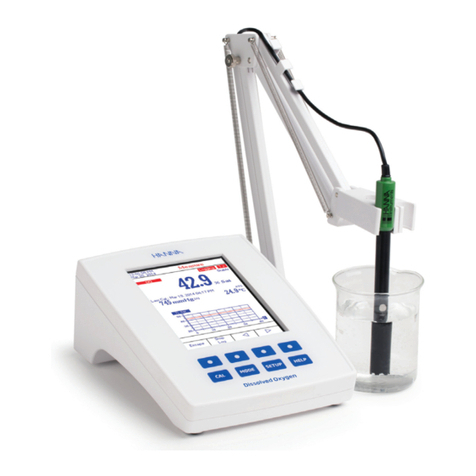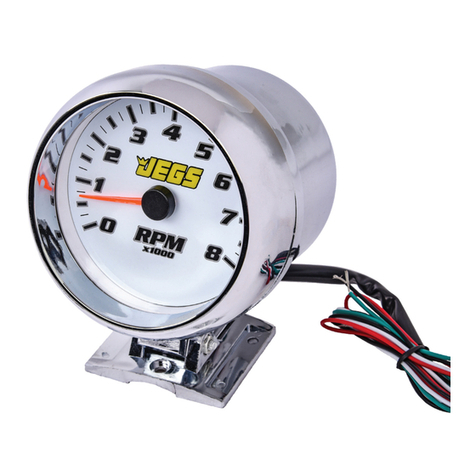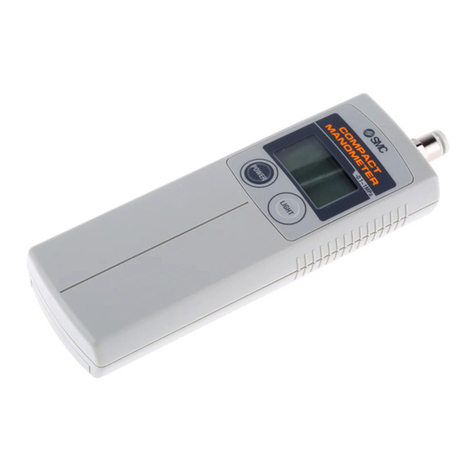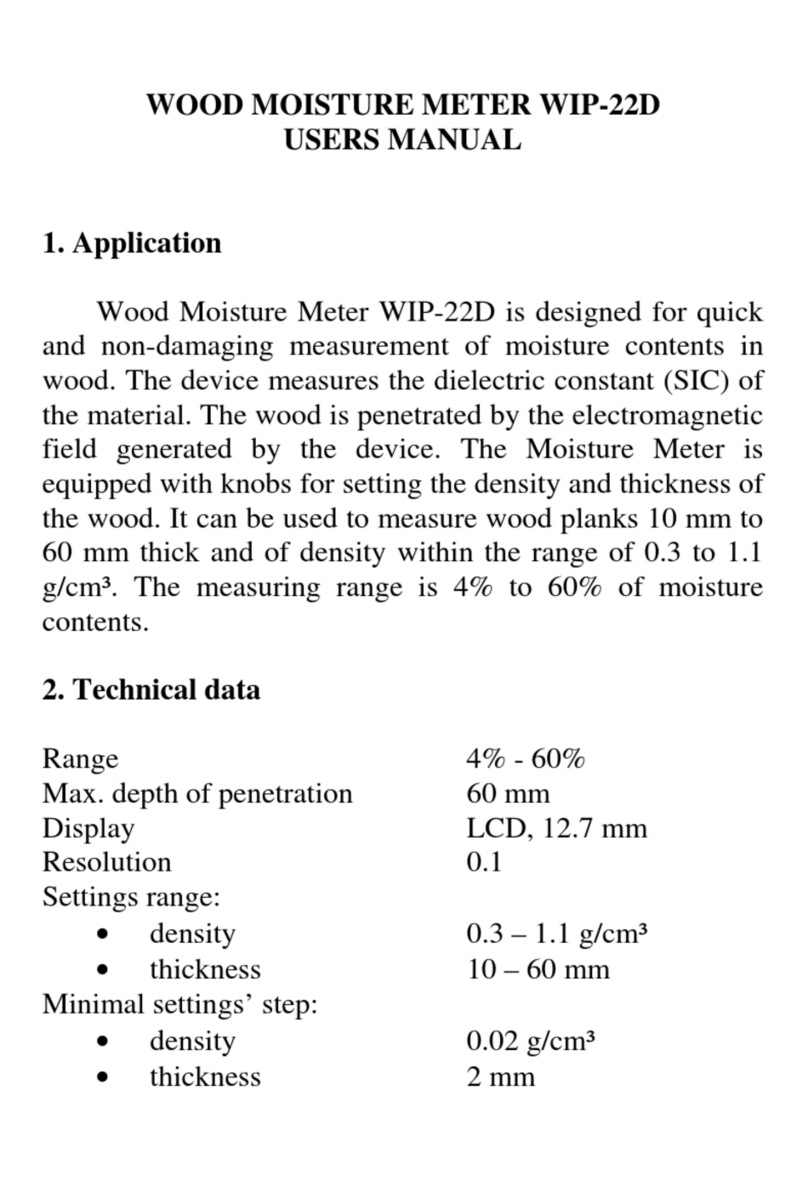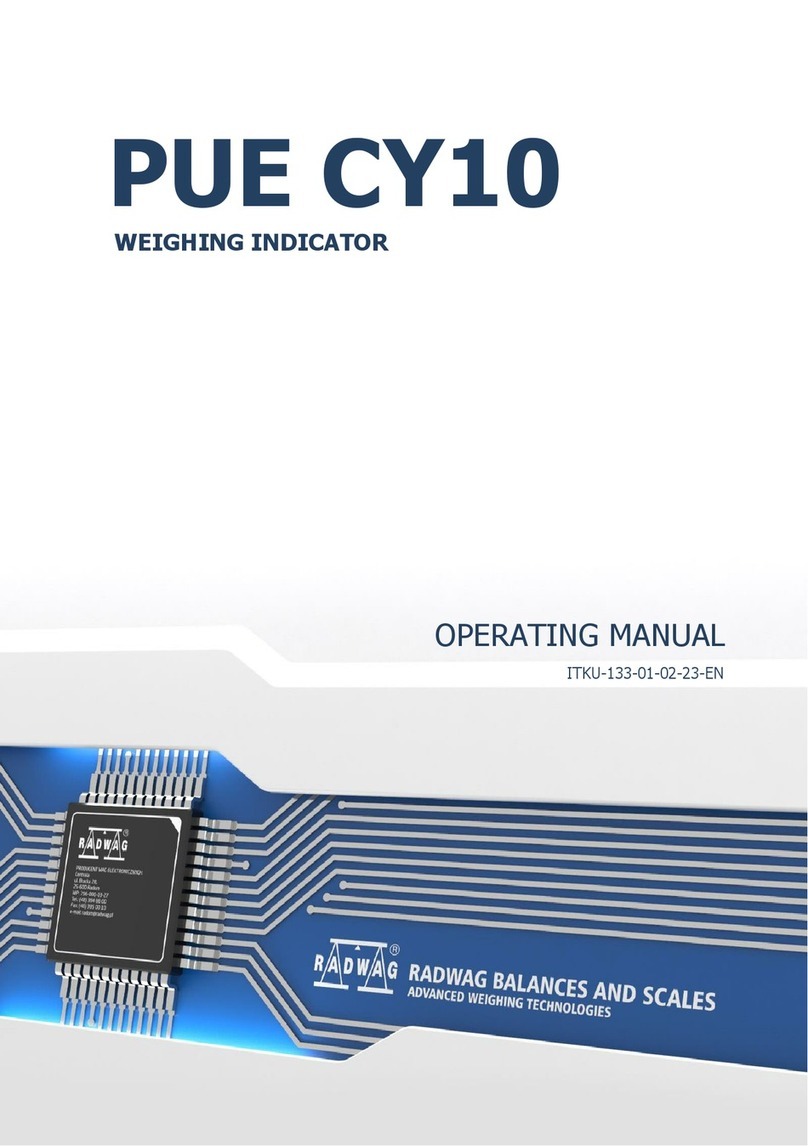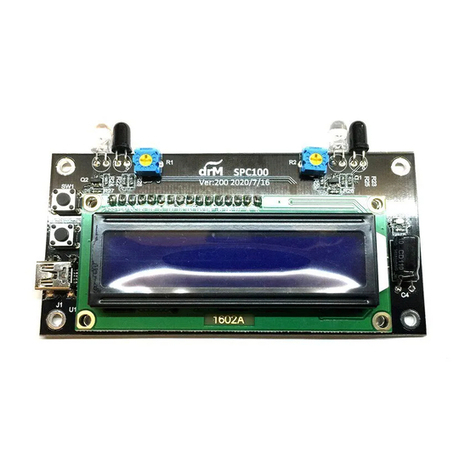Sensit GOLD 100 User manual

851 Transport Drive • Valparaiso, IN 46383 (USA)
Phone: 219.465.2700 • www.gasleaksensors.com
Gas Detection Instrument
Warning: To prevent ignition of ammable
or combustible atmospheres, disconnect
power before servicing.
7WA6
Approved UL913, For Class 1,
Division I, Groups C & D
hazardous locations when used
with alkaline batteries.
INSTRUCTION MANUAL
SENSIT®GOLD 100
Read and understand
instructions before use.
For use with combustible gases and optionally available
oxygen and toxic gases.

ii
⚠NOTICE: LEL sensor should be checked for accuracy after
exposure to any gases containing silicones, high sulfur content, high
concentrations of propane and high concentrations of CO (above
1000ppm) or exhaust gases. Continuously low calibration check results
or uctuation of zero readings may indicate sensor end of life or failure.
Consult Sensit Technologies with any questions.
For best accuracy always zero in clean air environments similar in
temperature and relative humidity to the environment where the
instrument will be used. When continuously exposed to combustible gas
concentrations beyond LEL for longer than 5 minutes always perform a
calibration check prior to the next use.
⚠Warning: To reduce the risk of ignition of a ammable atmosphere,
batteries must only be changed in an area known to be nonammable.
Do not mix batteries of dierent age or type.
Not for use in atmospheres of oxygen greater than 21%.
ONLY zero instrument in a gas free environment.
⚠Warning: To maintain intrinsic safety, service must be performed
by factory authorized technicians with approved replacement parts only.
FOR YOUR SAFETY
NOTICE: ⚠CAUTION: This safety symbol is used to
indicate a potentially hazardous situation which, if not
avoided, may result in minor or moderate injury.

3
CONTENTS
Preparation
For Your Safety .............................................................. ii
Contents .................................................................... 3-4
Parts and Accessories ...................................................5
General Description .......................................................6
Sensor Specications ....................................................7
Product Specications ...................................................7
Product Features ..................................................... 8-10
Sensor Types and Pumps ...........................................11
Basic Operation
Battery Installation/Replacement .................................12
Operation and Use ................................................ 13-17
Calibration Check ........................................................18
User Menu and Detailed Operation
User Menu / Function Descriptions ....................... 19-20
Printing to Optional IR Printer ......................................21
Gas Type .....................................................................22
Power O - Automatic Shut-O ...................................23
Set Clock .....................................................................24
Calibration Log: Show and Print Calibration Log .........25
Session Log: Show and Print Session Log............ 26-27

4
CONTENTS
Tests and Calibration
Bump Test ....................................................................28
O2 Test ........................................................................29
Smart-Cal ....................................................................30
Autolog ........................................................................31
CO Test and How to Conduct a CO Test .....................32
Show and Print CO Test ..............................................33
CF Test and How to Conduct a CF Test ................ 34-35
Show a CF Test ...........................................................36
Print a CF Test .............................................................37
Calibration Notes .........................................................38
Carbon Monoxide (CO) Calibration .............................39
Hydrogen Sulde (H2S) Calibration ............................40
Combustible Gas Calibration (50% LEL Methane) ......41
Combustible Gas Calibration (100% Methane) ...........42
Combustible Gas Calibration (1.1% Pro or 50% LEL Pro) ...43
Oxygen Sensor (O2) Test ............................................44
Using The Smart-Cal Calibration Station .....................45
Factory Adjustble Features ..........................................46
Warranty ....................................................... Back Cover

PARTS AND ACCESSORIES
Standard Accessories (Included)
872-00001 Hard Carrying Case
360-00040 Wrist Strap
870-00018 Extra Sensor Cap with O-Rings
750-00038 Instruction Manual
310-00004 3”C” Alkaline Batteries
Accessories and Replacement Parts
870-00018 Sensor Cap with O-Rings
870-00012 Extension Adapter
873-00016 Hydrocarbon Filter (1)
883-00023 Hot Air Probe Assembly
883-00021 32” Heavy Duty Fiberglass Probe
883-00015 Conned Space Probe with Tubing
883-00019 32” Fiberglass Probe
873-00025 Dirt and Water Filter Assembly
873-00013 Inline “Mini” Hydrocarbon Filter
870-00004 IR Printer
870-00039 IR Link Interface w/ SmartLink Software
914-00000-01 Smart-Cal Automatic Calibration Station
Calibration Kits
Contact us with instrument model number for correct Calibration Kit.
5

GENERAL DESCRIPTION
The SENSIT® GOLD 100 is designed to detect combustible gases,
oxygen content and toxic gases when so equipped with the available
sensors. Each model of the SENSIT® GOLD 100 provides specic
detection features based on available sensor options. Each SENSIT®
GOLD 100 can be re-congured or upgraded by the manufacturer for
an additional charge should your sensing requirements change. Consult
Sensit Technologies for a listing of new sensors available for use with the
SENSIT® GOLD 100.
All SENSIT® GOLD 100 instruments incorporate an advanced low power
semiconductor sensor to measure combustible gases in LEL (Lower
Explosive Limit) range. The reading is displayed in the percentage of
the lower explosive limit or, if so ordered, in parts-per-million from 0 to
2,000ppm. An automatically backlit display shows all gas concentrations
being measured. LEDs located on the front of the instrument indicate
preset visual warnings of increased gas concentration. All gases are
continuously sampled with the use of an internal pump.
Audible and visual alarms warn the operator of hazardous conditions
being sensed. The preset alarms are indicated by a red ashing LED,
display indicator and alarm sound. The combustible gas alarm is preset
at 10% LEL methane.
The carbon monoxide (CO) alarm is factory preset at 50ppm. The oxygen
(O2) alarm is preset at 19.5% and above 22.5%. The hydrogen sulde
(H2S) alarm is preset at 10ppm.
The SENSIT® GOLD 100 instrument is approved by Underwriters
Laboratories to UL913, for Class I, Division 1, Groups C & D hazardous
locations when used with approved batteries.
APPROVED BATTERIES: Duracell MN 1400BK or equivalent alkalines.
Panasonic HHR300CH or equivalent NiMH (Nickel Metal Hydrides).
6

SPECIFICATIONS
SENSOR SPECIFICATIONS
TYPE RESOLUTION RANGE ACCURACY
LEL 0.1%** up to 2% 0-100% LEL ±10%
%GAS .01% . 2.5-100% GAS ±5%
PPM 1ppm or 10ppm 0-2,000ppm ±10%
Increments
O2 0.1% . 0-25% ±0.2% or 10%**
CO 1ppm 0-2000ppm ±5ppm or 5%**
H2S 1ppm 0-100ppm ±2ppm or 5%**
** Whichever is greater
PRODUCT SPECIFICATIONS
Size: 11.5” x 3” x 2.32” (292 x 76 x 59 mm)
Weight: 1.2 lbs. (544 g)
Operational Temp: 0 to 120° F (-17.8 to 48.8° C)
Storage Temp: -20° to 132° F (-28.9 to 55.6° C)
Battery Life: Alkaline: approximately 12 hrs. continuous
Approved by Underwriters Laboratories to UL913, for Class I, Division 1,
Groups C & D hazardous locations when used with approved batteries.
APPROVED BATTERIES: Duracell MN 1400BK or equivalent alkalines.
Panasonic HHR300CH or equivalent NiMH (Nickel Metal Hydrides).
7
7WA6

8
PRODUCT FEATURES
LUER PROBE CONNECTOR
WATER / DIRT FILTER
LEL / PPM SENSOR
INFRARED COMMUNICATIONS
BACKLIT LCD DISPLAY
ALARM LEDs
OPERATION BUTTONS
TICK ADJUST
FLEXIBLE GOOSENECK
BATTERY COMPARTMENT

9
PRODUCT FEATURES
SENSIT® GOLD 100 instruments are constructed of durable ABS plastic
to withstand the rigors of eld use.
Incorporated in the hand grip area is the battery compartment. All
SENSIT® GOLD 100 instruments require 3 “C” type alkaline batteries.
APPROVED BATTERIES: PROCELL® MN 1400 batteries or equivalent
alkalines provide approximately 12 hours of use.
A tick adjust knob is located on the right side of the instrument that
activates the audible tick sound that helps in locating the source of a gas
leak. This tick is generated by using specialized circuitry in combination
with the LEL sensor located at the end of the gooseneck assembly.
The tick can be easily heard with the speaker located in the back of the
instrument.
An infrared communication window is located on the right side to allow
the SENSIT® GOLD 100 instrument to download calibration data,
readings the operator has elected to save to the on board memory, as
well as communicate with the Smart-Cal Calibration Station and IR-Link
computer interface with SmartLink Software.

10
PRODUCT FEATURES
A exible gooseneck is used to assist in locating the source of gas
leaks and for remote sampling. A water/dirt trap is located at the end
with a convenient luer style connector to attach sampling and probe
accessories.
A two line display continuously updates the operator of all available gas
concentrations and alarms simultaneously as well as indicates internal
functions such as air ow and battery power.
Below the display is a series of LEDs that are preset to indicate
combustible gas concentrations. The red LED on the right side will ash
during any alarm condition.
There are 3 operational button pads on the front of all Sensit®Gold
instruments.
BUTTON (A) POWER/MUTE
Operates POWER and MUTE features and exit menu items.
BUTTON (B) MENU
To enter, change and select menu items.
BUTTON (C) SAVE/ZERO
Use for save data feature, manually zero sensors, scroll and change
menu items.

11
SENSOR TYPES AND PUMPS
Combustible Gas Sensor
All SENSIT® GOLD 100 instruments incorporate a highly sensitive and
uniquely designed semiconductor sensor. The function and accuracy of
the sensor are monitored and controlled by specialized circuitry and a
microprocessor.
This sensor is capable of measuring concentrations as low as 1ppm
methane up to 100% LEL. Concentrations above 70% LEL are monitored
or measured simultaneously with a state-of-the-art thermal conductivity
sensor (TC).
This sensor is capable of measuring high concentrations of gas quickly
and accurately. All readings are automatically switched between the
scales of PPM (if so equipped), LEL and percent volume.
The Pump
The SENSIT® GOLD 100 instruments are equipped with a powerful and
ecient diaphragm pump. A water/dirt lter at the end of the gooseneck
protects the pump from foreign material. An additional internal lter also
helps to protect the pump from damaging debris. There are audible and
visual indicators that will show a blocked or improperly operating pump.
NOTE: Operating the instrument without a sensor cap or with an altered
sensor cap can cause damage to the instrument and void the warranty.

12
BATTERYINSTALLATION/REPLACEMENT
Battery replacement is necessary when the display reads BAT LOW,
an audible alarm sounds and the green ready LED ashes. When the
instrument remains in BAT LOW, a count down will appear starting at
300 seconds (5 minutes) which is the maximum time remaining before
shut down.
⚠CAUTION: Always change batteries in an environment free of
combustible gases.
Remove the battery sleeve cover by depressing the locking tab on the
front of the handle with a coin or at object and pulling the handle away
from the top or display area of the instrument.
NOTE: Observe the polarity markings on the inside of the battery
holder. Improper battery installation will disable the instrument.
Place three (3) approved batteries into the battery holder. For best
results hold the battery compartment so that it lays in one of your hands.
With your other hand install the battery that goes toward the front contact
spring connector (top) rst. The battery that is in contact with the rear
spring connector second. Finally insert the third battery in the center
position by moving the rst and second so that it compresses the spring
contacts and allows the battery to go into place. If you do not use one of
your hands to hold the bottom of the battery compartment the batteries
may come out.
Replace the battery sleeve and allow the locking tab to snap into
position. Check to be sure the handle is secure to the instrument body
by gently pulling the handle away. The handle will remain rmly in place
if a proper connection is made.

13
OPERATION AND USE
⚠CAUTION: Always start any SENSIT® GOLD 100 in a gas free
environment to insure a proper zero.
1. Push the POWER/MUTE BUTTON (A). The following start-up
sequence will be displayed.
a. Product name and model version number
b. System check for proper pump ow and battery strength
c. Date and time
d. Gas type
e. Serial number
f. Warm-up period. Minimum 30 sec., maximum 5 min.
g. Autozero of sensors
h. Work display
2. If the display fails to illuminate or BAT LOW is shown on the display,
replace the batteries. There is room in the carrying case to keep an extra
set.
3. If any sensor is past the intended calibration cycle, CAL DUE will
appear during the start-up sequence. The instrument will also show
which sensor is due for calibration at that time.
4. If after the warm-up period, the instrument determines that a sensor
is inoperable, an ERROR message will ash for that sensor. Then FAIL
will show on the display for the corresponding sensor.
5. The display will indicate LEL readings by showing an “L” next to the
% symbol. Standard resolution is 0.1% LEL, the equivalent of 50ppm
methane. As an option, the instrument is capable of displaying a range of
0.1% LEL up to increments as high as every 2% LEL.

14
OPERATION AND USE
An alternative option is to request a PPM display. Resolution for this
option is 1ppm or every 10ppm. An X on the display indicates that the
instrument is not outtted with that sensor.
6. Prior to use, test the integrity of the sensor cap and tubing. Use your
nger to block the inlet of the sensor cap for 4-5 seconds. The display will
read FLOW BLOCKED if all seals are intact. If this does not occur, change
the sensor cap and “O” rings. A spare sensor cap and “O” rings are
supplied with each instrument. During pump ow block, a beep will occur
every 2 seconds until the pump restarts and adequate ow is present.
7. It may be necessary to manually zero the instrument based on
company practices and environmental conditions. Always zero the
instrument in a clean air environment.
8. When testing areas with elevated temperatures such as appliance
vents or ues, always attach the optional hot air probe to the end of the
sensor cap. These connections need only be nger tight. Failure to use
the approved probe can result in damage to the instrument and may
void the warranty.
⚠CAUTION: Do not handle the steel portion of any hot air probe
after use as burns may occur!
9. When sampling high areas or overhead lines the use of the optional
extension adapter will allow a broom handle or painters stick to extend
the instrument to the area where sensing must be accomplished. This
adapter slides onto the battery sleeve and is held in place by the locking
nut assembly.

15
OPERATION AND USE
10. When sampling areas the appropriate sensors will cause the display
to update when a gas is encountered. Additionally, if a combustible gas is
encountered a series of LEDs on the front of the instrument will illuminate
when the preset concentrations are reached. If any alarm condition exists
for any sensor, based on their preset alarm points, the red (HAZARD 3)
LED will ash and the alarm will sound unless it is muted.
Additionally, the reading for the gas exceeding the alarm set point will also
ash. The standard factory preset LED indicators and alarm points are:
a. Combustible gas: Methane, audio and visual alarm indicators
from 10% LEL to 100% LEL.
i. Green LED/Ready = 0% - 4.9%LEL Methane
ii. Amber LED/Low = 5% - 9.9%LEL Methane
iii. Red LED/Haz1 = 10.0% - 24.9% LEL Methane
iv. Red LED/Haz2 = 25.0% - 49.9% LEL Methane
v. Red Flashing LED/Haz3
METHANE: 50% LEL Methane to 17% volume Methane
(LED indicator only above 17% volume Methane)
PROPANE: 50% LEL Propane to 12% volume Propane
(LED indicator only above 12% volume Propane)
b. Oxygen - Below 19.5% and above 22.5%
c. Carbon Monoxide - 35ppm per utility industry standards
d. Hydrogen Sulde - 10ppm and above per Federal OSHA guidelines
⚠CAUTION: There are gases that can poison or be cross sensitive
to the combustible gas sensor.

16
OPERATION AND USE
11. To disable the alarm, quickly press the POWER/MUTE BUTTON (A).
To enable the alarm press the same button again. During an alarm the
gas that has exceeded the preset alarm point will ash on the display and
the HAZARD 3 LED will ash indicating a potentially unsafe condition.
When combustible gas readings exceed the alarm range, all LEDs (except
green and red HAZ3) will turn o.
12. To assist in locating the source of small combustible gas leaks or
surveying areas outdoors or indoors, rotate the thumbwheel located
on the right side of the instrument until a steady ticking sound is heard.
NOTE: There is no warm-up for this feature as it uses the LEL sensor that
is already operating.
Move the sensor head toward the area suspected of leakage. As the
sensor head moves closer to a leak source the tick will increase. When
the tick becomes a steady tone rotate the thumbwheel in a clockwise
direction while keeping the sensor head in the same position. This will
slow down the tick and allow the operator to nd a higher concentration
using the same procedure.
If the tick goes away you have moved away from the leak or there is no
more gas present. The leakage rate may be less than the rate that the
pump is drawing the sample. For best results always use the leak detector
prior to using any liquid leak detection uids as these sensors will detect
their presence.

OPERATION AND USE
13. At any time the operator may save the readings on the display by
pressing the ZERO/SAVE (C) button. This will save all readings for
download at a later time. The memory is factory set to store 6 events. This
can be adjusted from 1-15 at the factory. The most recent save is rst
during download. An optional Auto log software of extended memory can
store up to 1,600 records. (Consult factory for details.)
14. Following Federal, State, Municipal and/or Company procedures
move to the areas where gas readings are suspected or must be tested.
Use necessary accessories to draw samples from areas not accessible
with the instrument itself, such as conned spaces or ues. During
sampling, the respective readings may change. Audible and visual alarms
will activate when the preset limits are reached.
15. If the instrument encounters a gas it is not calibrated to, it may read
“NSR” followed by a number. If the instrument is calibrated for natural gas
“NSR” (Non Standard Reading) likely indicates a heavy gas (i.e.: heavier
than air, such as gasoline, propane, carbon dioxide, etc.). If the instrument
is calibrated for propane, “NSR” likely indicates gas lighter than air such
as hydrogen, helium, methane or natural gas.
16. When being used in dark areas an automatic backlight will illuminate
the display.
17. To turn instrument o, press/hold the POWER/MUTE BUTTON (A)
until the beeping sound stops, about 5-6 seconds. Release the button and
power down will occur.
17

CALIBRATION CHECK
To verify the accuracy of any SENSIT® Gold 100, it must be exposed to
a known concentration of test gas that will test any sensor combination
included in your particular model.
Any sensor that does not meet the specications listed in this manual
may require calibration or repair. A calibration check does not update the
calibration due date. Full calibration is required to update these times.
A calibration past due message will illuminate during warm-up if calibration
has not been performed per your company specied interval. Any time it
is suspected that the SENSIT® Gold 100 is not working properly, check
calibration.
18

19
USER MENU
The SENSIT® Gold 100 has several categories within the User Menu.
The rst nine elds are standard with all instruments. The last three
are only available in certain instrument models when ordered with the
Extended Memory option.
Print Session Logs, Cal Log, access Smart-Cal
communication, (print CO test or print CF test is
optional with some extended memory units).
Calibrate all sensors, access Smart-Cal
communication.
Select natural/methane or propane as primary gas
to be sensed.
Set the automatic shut o timer in minutes. (User
adjustable)
Set date and time. Displayed using a 24 hour
clock. (User adjustable)
Display last calibration of all sensors.
Display saved gas readings with the corresponding
date and time.
PRINT MENU:
CALIBRATION:
GAS TYPE:
POWER OFF:
SET CLOCK:
SHOW CAL LOG:
SHOW SES LOG:

20
MENU
The SENSIT® Gold 100 has several categories within the User Menu.
The rst nine elds are standard with all instruments. The last three
are only available in certain instrument models when ordered with the
Extended Memory option.
Perform automatic test for sensors response to
calibration gas within 60 seconds or less.
20 second test to check depletion of the O2 sensor
when exposed to the proper gas, such as 100%
methane.
Access Smart-Cal communication.
BUMP TEST:
O2 TEST:
SMART-CAL:
Automatic storage of peak gas readings of up to
1,600 events.
Display CO levels recorded during timed test.
Display calculated AIR FREE CO levels recorded
during timed test.
AUTO LOG:
SHOW CO TEST:
SHOW CF TEST:
NOTE: These additional elds found on certain models ordered with the
Extended Memory option.
Table of contents
Other Sensit Measuring Instrument manuals
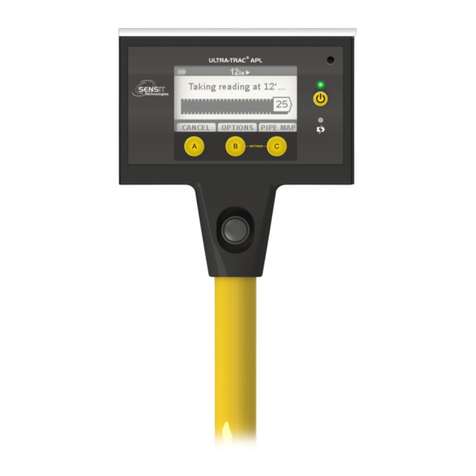
Sensit
Sensit ULTRA-TRAC APL Programming manual
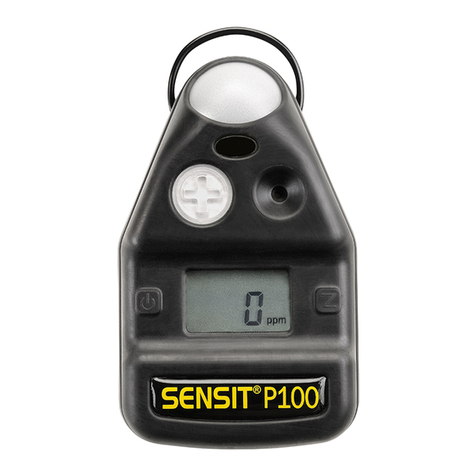
Sensit
Sensit P100 User manual
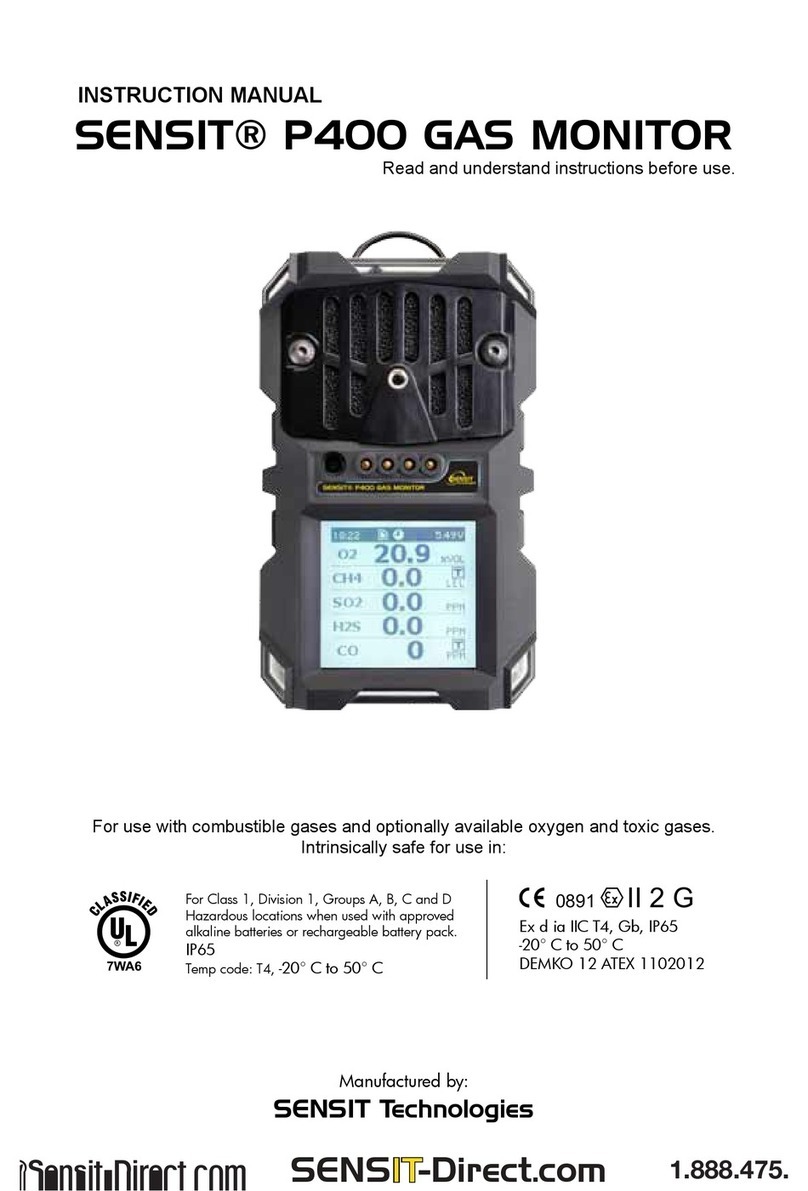
Sensit
Sensit P400 User manual
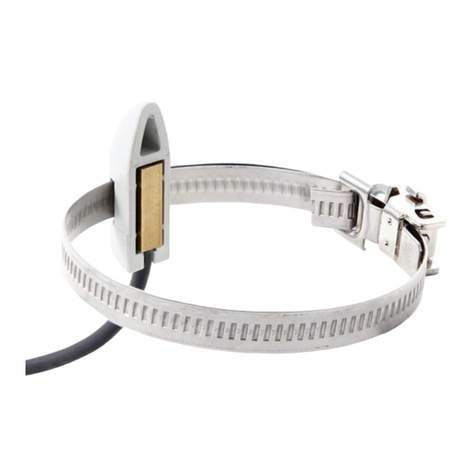
Sensit
Sensit PTS350A User manual

Sensit
Sensit CO User manual
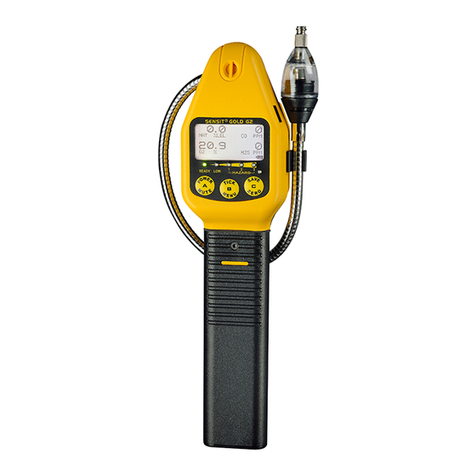
Sensit
Sensit GOLD G2 User manual
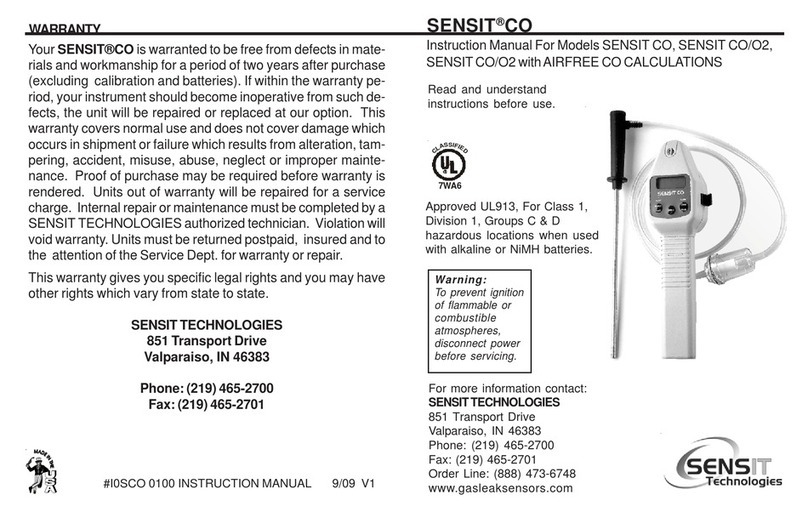
Sensit
Sensit CO User manual
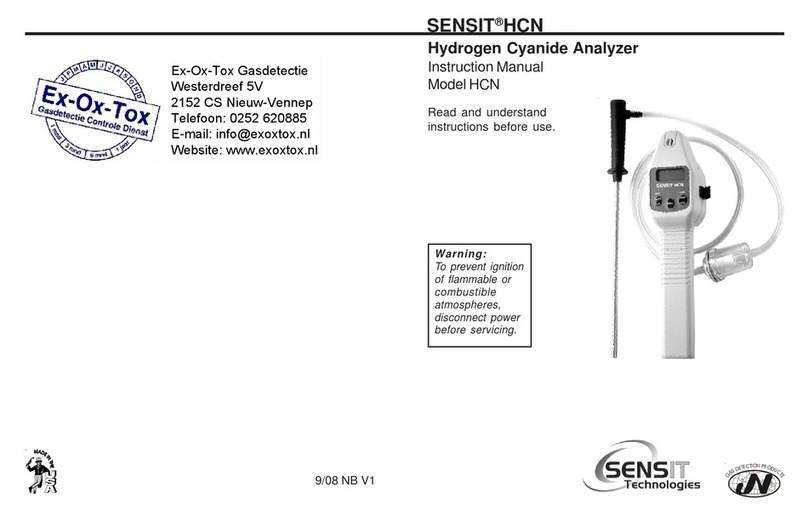
Sensit
Sensit HCN User manual

Sensit
Sensit HXG-3 Programming manual

Sensit
Sensit HCN User manual
Popular Measuring Instrument manuals by other brands

IFM Electronic
IFM Electronic efector 300 SV Series operating instructions

Rotronic
Rotronic CRP5 SERIES manual
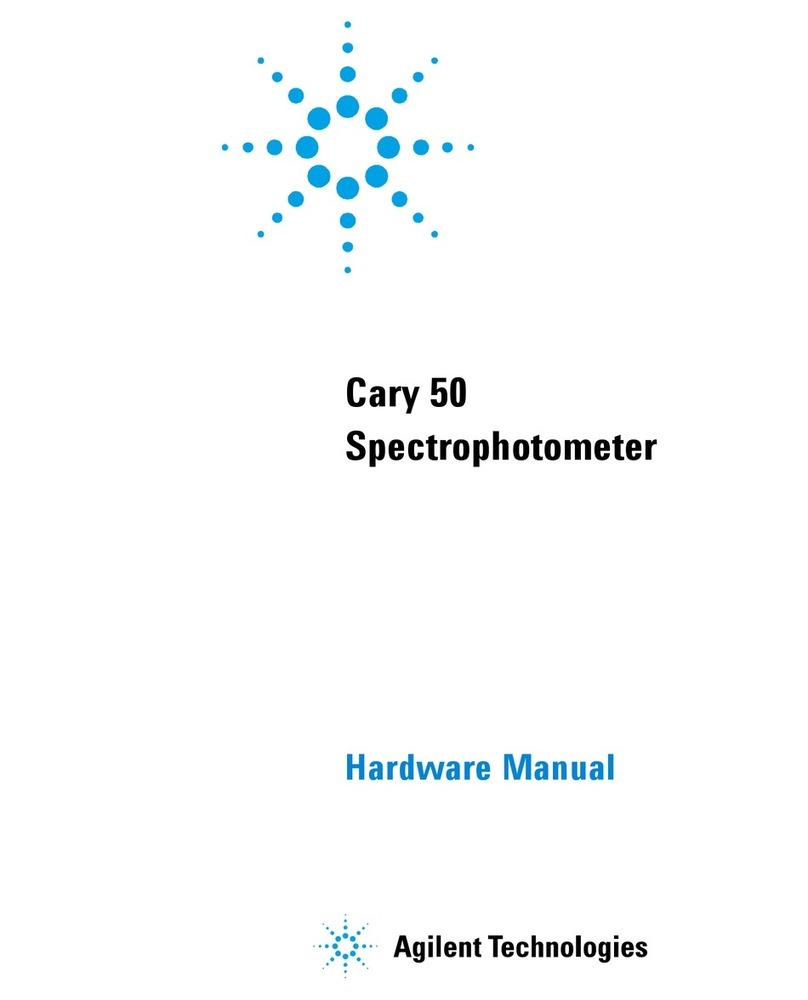
Agilent Technologies
Agilent Technologies Cary 50 Hardware manual
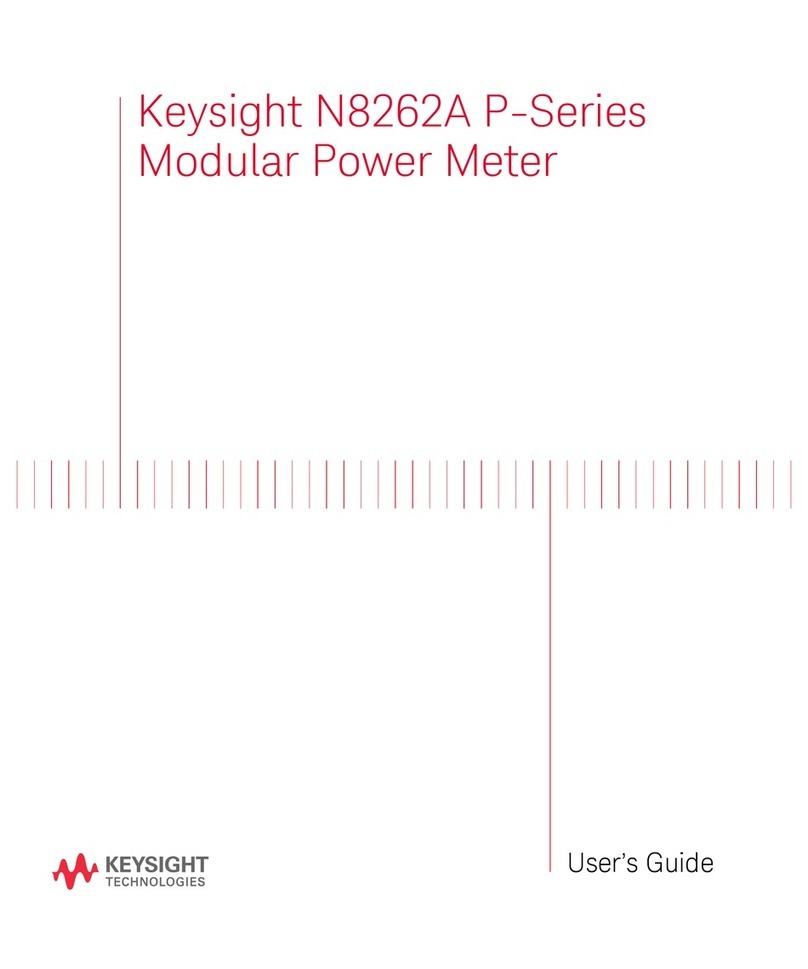
Keysight Technologies
Keysight Technologies N8262A P Series user guide
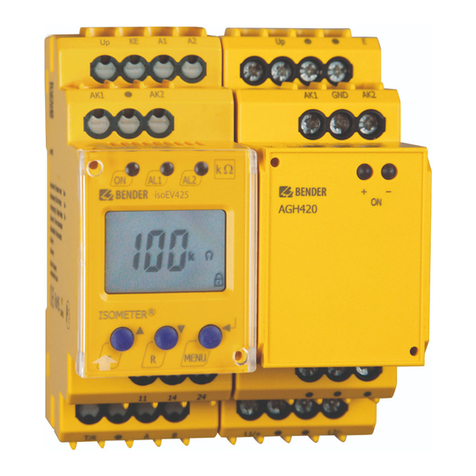
Bender
Bender ISOMETER isoEV425 manual
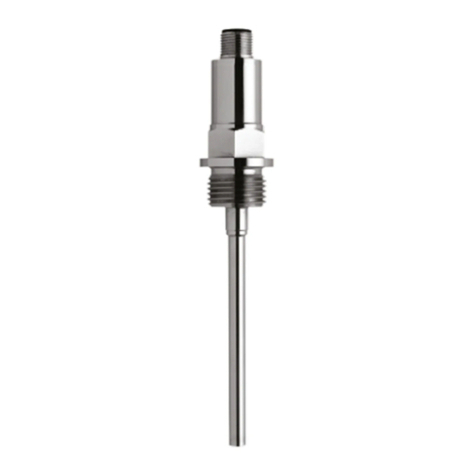
JUMO
JUMO Dtrans T100 operating instructions

